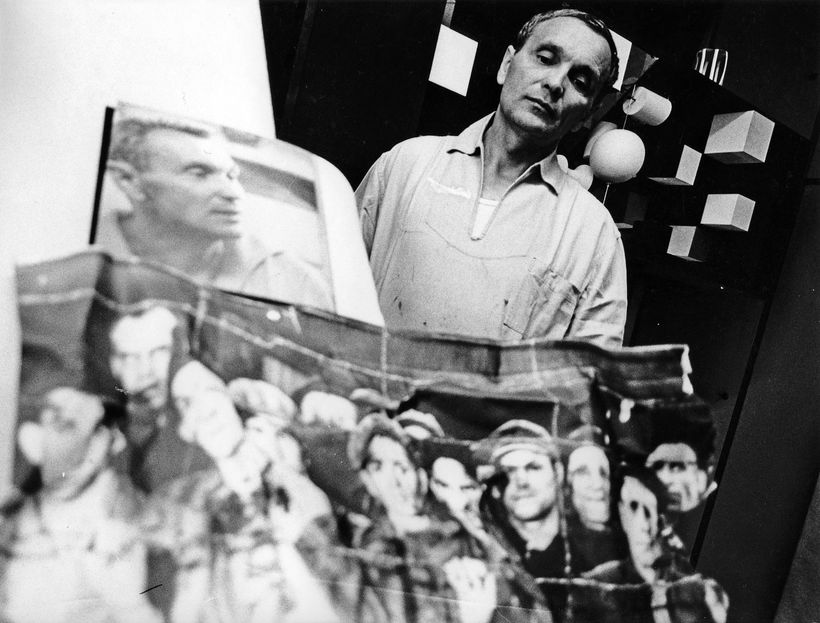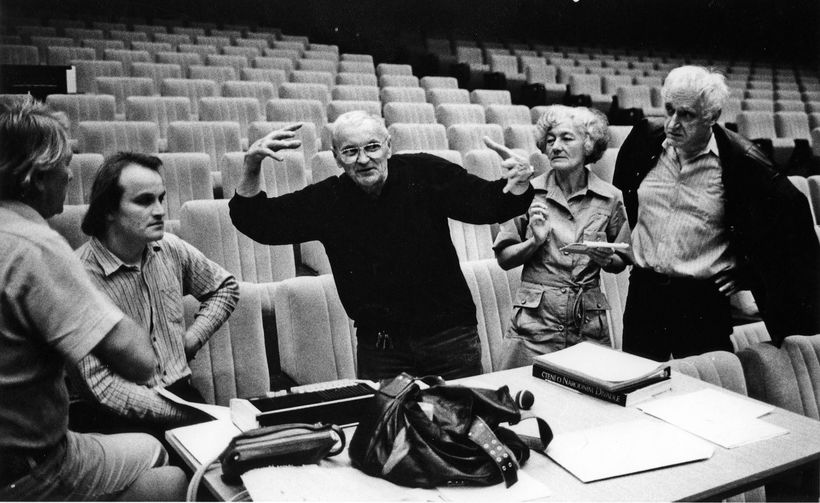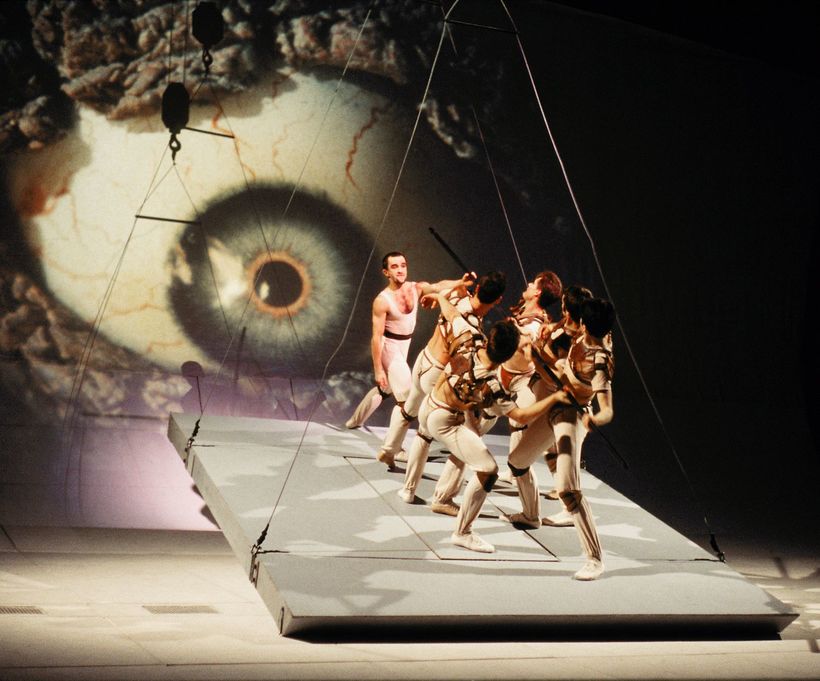He studied stage design and architecture from 1945 and already at that time he was accepted as head of production at the Theater of the Fifth of May (later the Smetana Theater and the Prague State Opera), where he created one of his most famous scenographies for the Tosca opera two years later. His set is in a sense alive to this day. In 1999 set designer Daniel Dvořák, Svoboda’s pupil and then director of PSO, restored it, so that it could be restored again in 2017. His scenography for Don Giovanni at the Estates Theater, in which he used a copy of the architectural elements of the theater itself, is possibly even more famous. The opera, directed by Václav Kašlík, premiered in 1969 and is still (on and off) in the repertoire.
Laterna magika
Thanks to plans for a representative project for the first EXPO world exhibition in 1958 in Brussels, set designer Josef Svoboda and director Alfréd Radok were commissioned to create this project, as well as the means and support to create an experiment that promised to appeal to the world. Under the guise of promoting Czechoslovak cultural heritage, they fulfilled their dream of multimedia theater. Alfréd Radok followed in the footsteps of E. F. Burian and the theatrical avant-garde, while Josef Svoboda throughout his life promoted the equality of all stage components and the harmony of their common effect. Svoboda and Radok have experimented with the film screen before. The production of the Eleventh Commandment, which was created eight years before Laterna Magika, is especially remembered. The creators wanted the best language possible to address the modern viewer, draw him into the world of the performance he is watching, and amplify his experience by all conceivable means.
.jpg)
Josef Svoboda. Photo: Archive of Josef Svoboda scénograf, o.p.s.
The performance, which organically mixed film passages with live performances by artists, entertainers speaking to themselves in several world languages, editing and modern camera work, timing of performances and their diversity and perfection of technical execution, all guaranteed sensational success in Brussels at Expo 58. The program called Laterna magika helped the Czechoslovak pavilion to victory among the exhibitors. The creation of a new theater ensemble was sealed at the time and the company had its own experimental stage within a year.
At the end of the 1960s, the situation in culture led to the emigration of director Radok, therefore Laterna magika is eventually more closely connected with the legacy of Josef Svoboda. He became its artistic director in 1973 and after the revolution, when it became independent, its director for several years. Svoboda created for Laterna Magika until the end of his life (he died on April 8, 2002). During the reconstruction of the National Theater at the turn of the 1970s and 1980s, Josef Svoboda reminded the management of the idea of setting up a separate building for Laterna magika, which was supposed to be the New Stage then under construction. In the end, however, it was completed according to a design by Karel Prager. Laterna magika first appeared on the New Stage in 1984 with the family opera Žvanivý slimejš (The Chattering Slug), and later the Magic Circus opened there. Since 1992, only Laterna magika performed on the New Stage for the entire period of its independent operation, until the end of 2009.
Polyecran, polyvision, virtual screen
Svoboda designed scenographies for Czech and world stages, he was also the inventor of modern lighting technology: the so-called Svoboda ramp is a light source for vertical lighting, which creates a strong luminous flux in the form of a strip, and the individual parts can be folded into any length. At the same time, since Expo 58, Svoboda has been working on Polyekran, a system of projection screens on which it is possible to create a composition of films or photographs without the presence of performers. At Expo 58, he used this system as a virtual exhibition space, together with Emil Radok, Alfred's brother, as director.
.jpg)
Josef Svoboda with Michal Kocáb a Evald Schorm. Photo: Archive of Josef Svoboda scénograf, o.p.s.
For Expo 67 in Montreal, Canada, Josef Svoboda created the Polyvision system, which worked with three-dimensional projection screens in space. The next stage was the diapolyekran, where a seemingly solid projection screen is divided into a number of moving projection surfaces, so that a collage is created, which can also take the form of a movable 3D relief.
In Laterna magika, he invited the director Evald Schorm, who created the immortal Magic Circus (1977), to collaborate. Josef Svoboda created a seemingly simple scenography for it, with a projection not only on a classic screen, but above all on the fabric lining the entire stage in a semicircle as an arena or a tent, thus creating the illusion for the audience that they are part of the stage.
Josef Svoboda experimented with projection screens, with the use of various materials, but also with television technology and live broadcast in the drama production of Night Rehearsal by director Antonín Máša. In Black Monk, the projections were projected again onto the pleated fabric while the classic projection screen was not used at all. One of the most ambitious scenographic sets was Odysseus (1986), created for the Palace of Culture and the second version six years later for the New Stage of the National Theater.
For the composed program Trap in 1999, Josef Svoboda created his last invention, the so-called virtual screen. A special structure resembling a sloping glass wall was built between the dancers and the audience and was covered by a semi-permeable layer. Thanks to it, the projection could be projected for the first time directly in front of the dancers; the disadvantage was that it was not visible from the point of view of the performers. The virtual screen was used again in the Graffiti program, which was on the repertoire until 2014.
.jpg)
Laterna magika - Odysseus (archiv ND).
Svoboda worked abroad for the first time in 1958, when he built a stage for Rusalka by director Václav Kašlík in Venice. He has created works for many major stages and festivals, including the Paris Opera, the Metropolitan Opera in New York and the Wagner Festival in Bayereuth. He was a professor at the Academy of Arts, Architecture and Design in Prague, but also led a master class of scenography at foreign universities, such as the Pratt Institute in New York and the Banff Center in Canada.
Already in 1966, he won the British Critics 'Award for the best scenography of the year for the opera The Storm, and in Los Angeles the Critics' Award for the scenography of Laurence Olivier's film Three Sisters. He has received the International Theater Award, The Royal Industry Designer title in Britain, as well as honorary doctorates from the Royal College of Arts in London, Denison University and Western Michigan University in the United States, and the U.S. Institute for Theater Technology Award. In France, he was awarded the Order of Arts and Fine Literature and the Order of the Legion of Honor.
In the 1960s, Josef Svoboda wrote about his vision: “If we use film as an equal partner on stage, it means an image that cannot stand on its own, because it is intended to connect with the actors in a stage action, as well as on the other hand, the actors' performance cannot stand on its own without this film. It means a complete combination of these two principles in the final action. However, it is impossible to use normal theatrical sets for this, and therefore it was necessary to create other principles for stage sets, which we now call kinetic scenography, or scenography that by editing and interweaving can change its spatiality and its function in the same rhythm as the film. ”
Josef Svoboda's work is still an inspiration for many scenographers and architects at home and abroad.
Sources:
Josef Svoboda – scénograf, o.p.s. (svoboda-scenograph.cz)
Svoboda, J.: Problémy scény Laterny magiky, in: Laterna magika, sborník statí. Filmový ústav, Praha: 1968.
Translated by Kristina Soukupová.




.jpg)
.jpg)
.jpg)